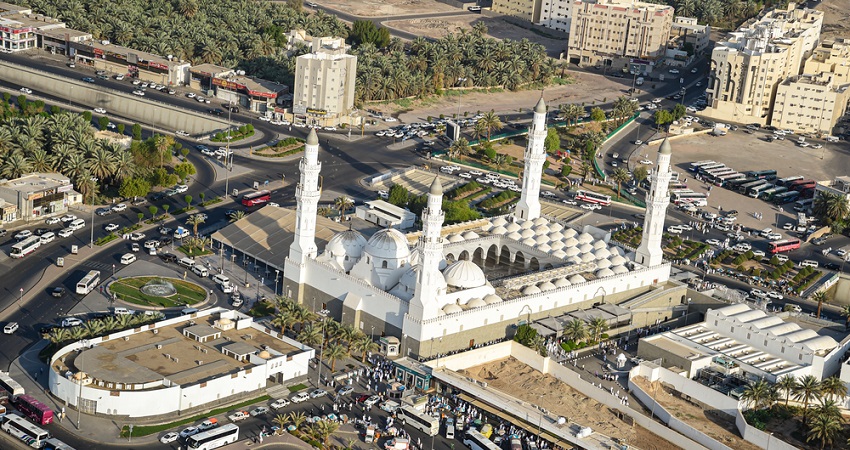The history of Masjid Quba, located in Madinah, makes it one of the most popular mosques among Muslims. It is an important site for tourists who come to the city and also for Hajj and Umrah pilgrims. Its history makes it an important spiritual attraction. The mosque was built in the outskirts of Madinah, around 6 kilometers far from the village of Quba. It dates back to the 7th century and is believed to be one of oldest mosques in the history of Islam. It is said that the first stones were laid out by Prophet Muhammad (PBUH) when he came back from Makkah.
Masjid Quba Location
Address: 3493 Al Hijrah Rd, Al Khatim, Medina 42318, Saudi Arabia
The Quba Mosque is located on the outskirts of Madinah, a major holy city in Saudi Arabia. Many centuries ago, when the mosque was built, it was about 6 km away from the main city of Madinah. It was located in a village named Quba and hence the name. Many years later, when the perimeter of Madinah was expanded to include the Quba village, it became a part of the holy city. Religiously, it is an important location because the Prophet (PBUH) stayed here when he came from Makkah. The mosque was then established at the same place by the Prophet himself.
Quba Mosque Architecture

The mosque, ever since it’s built, has been torn down and renovated only once followed by some additional renovations. The most recent construction in the Quba mosque was done in 1986. The renovated mosque has a rectangular prayer hall on the second floor which connects to several residential libraries, offices, shops, etc. It has 7 main entrances and 12 minor entrances with 4 parallel minarets and 56 mini domes which surround the mosque and acts as a perimeter. The courtyard is made out of black, red, and white marble. The minbar and the mihrab are composed of white marbles. The minarets are placed on square bases which have octagonal shafts, together of which take on a circular shape as they reach the top.
There is a prayer hall which is around the central courtyard surrounded by 6 large domes resting on clustered columns. It also consists of a portico which is two bays in depth. These border the courtyard on the east and west and separate the women praying hall with the men. The women’s praying hall is further divided into two.
Suggested Read : 8 Extremely Beautiful And Significant Mosques In Saudi Arabia
Significance of the Quba Mosque
The Quba Mosque is the second largest mosque and holds value to millions of Muslims around the world who wish to visit at least once in their lifetime. It is said that this place provides Umrah as the Prophet (PBUH) had mentioned that whoever would read Namaz here would receive one Umrah, which is almost equivalent to going on Hajj. Every place of worship for Muslims plays a very important role in the hearts of every believer. And a mosque that was built by the Prophet Muhammad (PBUH) himself is something every Muslim wants to see before their death.
First mosque of the world
Another reason Quba is such an important religious site in Madinah is that it is the first mosque in the history of Islam. It is also said to be the mosque where the first Friday ‘Namaz’ was held. The Hajj is performed in Madinah around this holy mosque.
The History of Masjid Quba
Islam, like most religions, has a history of wars and emerged victorious to inspire millions of people to follow Islam. During the 7th century, the time of Prophet Muhammad (PBUH), wars were a huge part that played in the making of Islam. After one of these wars was over, and the believers came back from Makkah along with the Prophet(PBUH) himself, the second most prestigious and largest mosque was built. History says that Quba initially was home to the tribe of Bani Amr bin Auf. Upon returning to Madinah, the Prophet decided to stop at Bani Amr bin Auf’s and build a mosque named Quba in his area.
One of the main reasons why this mosque is the most prestigious is because it is said that the Prophet’s female camel knelt here to drink water from a well that belonged to Hazrat Abu Ayyub Al-Ansari. It is because of this incident that the mosque became a blessed place. Also, because the Prophet(PBUH) stayed here for 3-4 days along with his companion Abu Bakr during the time of Hijrah. It is believed that the Prophet (PBUH) would go to the Quba mosque every Saturday riding his camel or by walking, to read two Rakats of Salah. It is therefore said that whoever reads Namaz in this holy house will be rewarded the same blessings as an Umrah.
Masjid Quba Renovations
The modern history of masjid Quba has seen renovations a few times. The first renovation was made by the third Caliph Uthman ibn Affan (peace and blessings be upon him). The first minaret was built by Umar ibn Abd al-Aziz, the eighth Umayyad caliph, who was also known as Umar II. Again in the year 435 AH, the mosque was renovated by Abu Yali Al-Husaini, who added the Mihrab, or the praying niche. The next set of changes were made by Kamal Al-Din Al-Isfahani, a celebrated Muslim poet, in the year 555 AH. Subsequently, it underwent many changes over the years, that is in 671 AH, 733 AH, 840 AH, 881 AH. The last renovation was done in the year 1245 AH by the Ottoman ruler, Sultan Abdul Majid.
Currently, the Quba mosque is under the charge of the Saudi regime led by the ruling king, Salman bin Abdulaziz Al Saud. It is managed by the Ministry of Hajj Affairs, which takes care of necessary maintenance and renovation to the structure. The mosque was expanded to include several new areas in 1986, under the rule of late King Fahd bin Abdulaziz. The modern structure is equipped with state-of-the-art facilities, three central cooling units, and has a total area to house over 20,000 worshippers.
Reward of praying in Masjid Quba
The Prophet (PBUH) said, “He who purifies himself at his home and comes to Masjid Quba and offers two rakats therein, will be rewarded the reward of an Umrah (lesser pilgrimage).”
— Sunan ibn Majah
Masjid Quba Hadiths
“Never stand (to pray) there (referring to a place of worship in which the hypocrites had used for harm and disbelief, as mentioned in the previous ayah). A place of worship which was founded upon duty (to Allah) from the first day is more worthy that thou should stand (to pray) therein, wherein are men who love to purify themselves. Allah loveth the purifiers.”
— Qur’an 9:108
“I saw the Prophet (PBUH_ when he constructed this mosque. He used to carry stones and rocks on his back until it was bent. I also saw dust on his dress and belly. But when one of his companions would come to take the load off him, he would say no and ask the companion to go and carry a similar load instead.”
— Al-Tabarani quoted Al-Shimous Bint Al-Nuaman
Ibn ‘Umar (PBUH) said, “The Prophet used to go to the Mosque of Quba every Saturday (sometimes) walking and (sometimes) riding.”
— Narrated by Abdullah bin Dinar
Narrated Ibn ‘Umar: The Prophet used to go to the Mosque of Quba (sometimes) walking and sometimes riding. Added Nafi (in another narration), “He then would offer two Rakat (in the Mosque of Quba).”
— Collected by Muhammad al-Bukhari, Sahih al-Bukhari Volume 2, Book 21, Number 285
Quba mosque Madinah is one of most revered places of worship for Muslims and has been important and relevant from the day one of its creation. The history of masjid Quba is abundantly clear from the number of times it is mentioned in the history of Islam and its evolution. It is recommended to visit this beautiful and holy place whenever you visit the city of the Prophet, peace and blessings be upon him.
Suggested Read:Top 10 Tourist Places To Visit In Madinah
History of Masjid Quba FAQs
Why does Quba Mosque hold importance to Muslims?
The Quba Mosque holds significance in Islam because according to history, one of the first hands in the construction of this mosque was of the Prophet Muhammad (PBUH) himself. Additionally, when the Prophet(PBUH) had been visiting from Makkah to Madinah, he discovered a village in the between, where he found that his camel knelt in a well around the mosque and drank water from it.
How many Muslims visit the Quba Mosque?
The mosque holds a capacity of around 20,000 Muslims who wish to pray in the praying hall. It is called a place where praying two Rakats of Namaz is equivalent to one Umrah.
Is Quba the oldest mosque in the world?
The Quba mosque is one of the oldest mosques in the history of Islam.
Why should one visit the Quba Mosque?
Apart from the Muslims who consider the mosque to be incredibly holy, tourists should visit the mosque because of its architectural value, the beautiful marble work, and the placement of the domes in the masjid.
Are women allowed in the mosque?
The Quba mosque has a special place for women inside the masjid. A prayer hall, especially for women, is reserved on the northern side of the mosque.
Who built Quba mosque?
The Quba mosque was built by the Prophet Muhammad, PBUH.
What is the distance from Masjid Nabawi to Masjid Quba?
Masjid Quba is 3.8 km from Masjid Nabawi.








